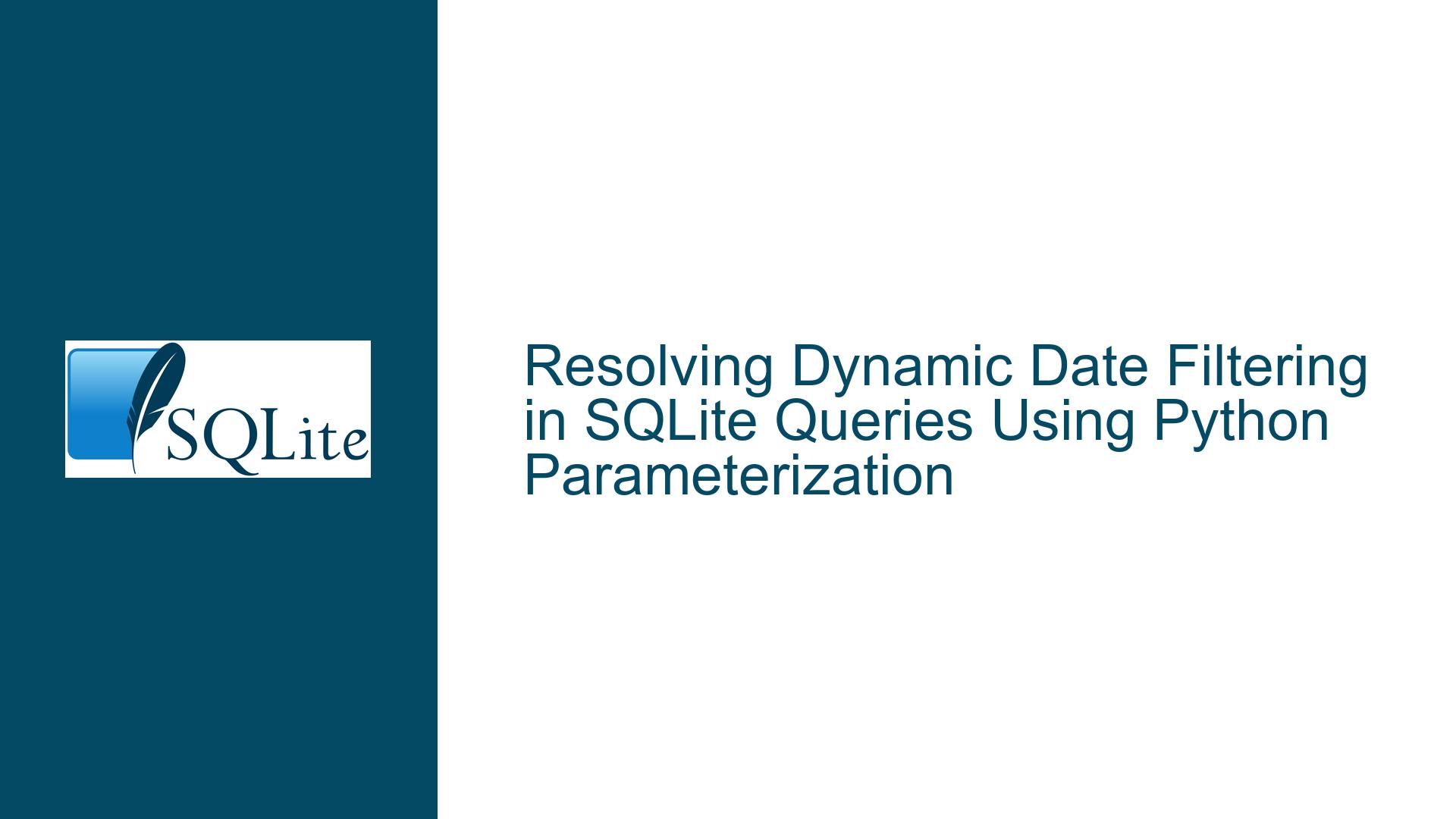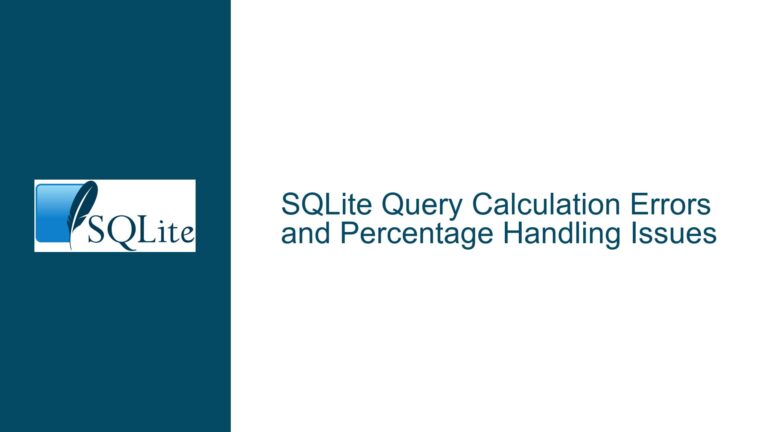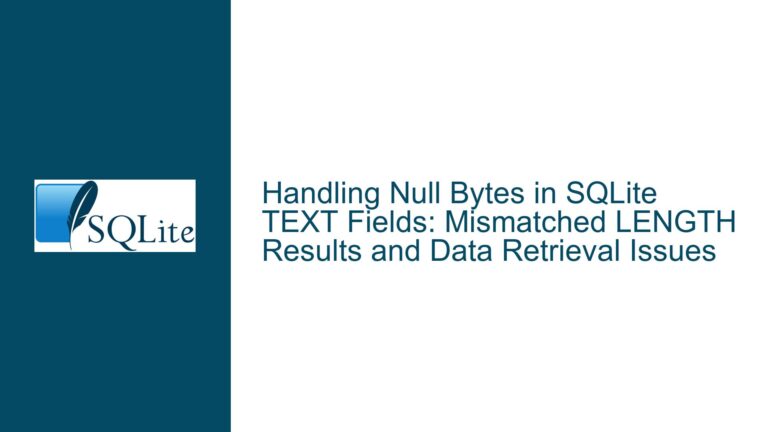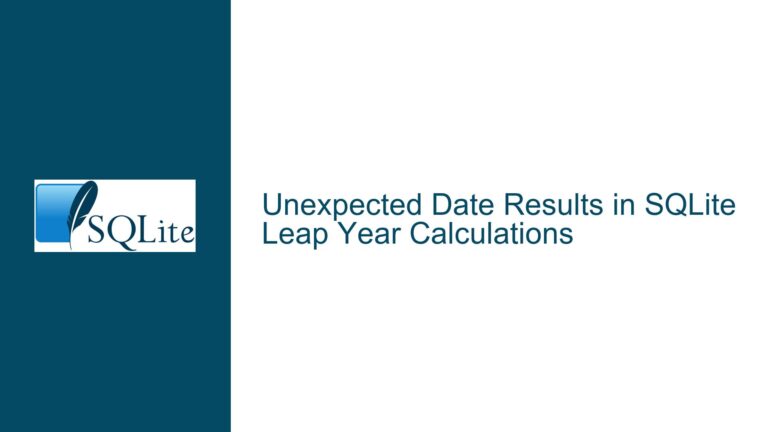Resolving Dynamic Date Filtering in SQLite Queries Using Python Parameterization
Issue Overview: Dynamic Date Filtering with SQLite Parameterization Challenges
When working with SQLite databases in Python, a common requirement is to dynamically filter records based on date values. This becomes particularly crucial when generating reports, aggregating time-series data, or performing temporal analysis. The core challenge arises when attempting to replace hard-coded date literals in SQL queries with programmatically generated date values while maintaining query security, accuracy, and performance.
In the presented scenario, we need to count records from a lightning detection system (NGXLIGHTNING table) that occurred on the previous day. The datetime_utc column stores event timestamps, and we need to filter records where these timestamps fall within a specific calendar date. The initial implementation uses a static date literal ("2023-10-13%") with the LIKE operator, which requires dynamic adaptation to use yesterday’s date calculated in Python.
Key technical components involved:
- Date calculation in Python using datetime module
- SQLite database connection management
- SQL query parameterization techniques
- LIKE operator behavior with date-time patterns
- Type conversion between Python and SQLite
The fundamental obstacle lies in properly integrating Python-generated date values into SQL queries while avoiding common pitfalls such as SQL injection vulnerabilities, string formatting errors, and temporal mismatches between application-layer date handling and database storage formats.
Possible Causes: Parameterization Pitfalls and Temporal Pattern Mismatches
1. String Formatting vs. Parameter Binding Confusion
Developers often attempt to construct SQL queries through string interpolation, especially when dealing with temporal filters. This approach creates multiple vulnerabilities:
# Risky string concatenation example
query = f'SELECT COUNT(*) FROM NGXLIGHTNING WHERE datetime_utc LIKE "{gestern:%Y-%m-%d}%"'
cursor.execute(query)
This method exposes the application to SQL injection attacks and breaks when date formats contain special characters. It also prevents SQLite’s query planner from optimizing execution plans through cached prepared statements.
2. Improper Wildcard Handling in LIKE Patterns
The LIKE operator requires explicit wildcard characters (% or _) to match patterns. When transitioning from hard-coded dates to dynamic parameters, developers might either:
- Omit the wildcard in parameter construction
- Misplace the wildcard relative to the date pattern
- Use incorrect wildcard characters
For datetime_utc values stored as ISO-8601 strings (e.g., "2023-10-13 08:30:45"), the pattern "2023-10-13%" correctly matches all times on that date. Failing to append the % character to the parameter value would result in exact matches only, potentially returning zero records.
3. Type Conversion Mismatches Between Python and SQLite
SQLite’s flexible typing system can lead to unexpected behavior when comparing date-like strings. Common issues include:
- Storing datetime_utc as UNIX timestamps (integers) instead of strings
- Using different date formats in the database (DD-MM-YYYY vs YYYY-MM-DD)
- Timezone offsets not being accounted for in UTC conversions
- Microsecond precision in stored timestamps that aren’t matched by the pattern
4. Implicit Query Parameter Limitations
While SQLite supports parameterized queries, the scope of parameter usage is limited to literal values. Developers might incorrectly attempt to parameterize:
- Table or column names
- SQL keywords or operators
- Wildcard characters within LIKE patterns
- Chunks of SQL syntax
This misunderstanding leads to attempts like:
# Invalid parameterization attempt
cursor.execute("SELECT COUNT(*) FROM NGXLIGHTNING WHERE datetime_utc LIKE ?%", (gestern,))
5. Timezone Handling Inconsistencies
The original code uses DateTime.utcnow() to calculate gestern (yesterday), but whether this aligns with the datetime_utc storage format depends on:
- Server timezone configuration
- Application timezone awareness
- Database timestamp storage conventions
A UTC datetime in Python might compare incorrectly with local-time timestamps stored in the database, leading to off-by-one-day errors.
Troubleshooting Steps: Parameterization Techniques and Temporal Pattern Optimization
Step 1: Validate Date Storage Format in SQLite
First, confirm the actual storage format of datetime_utc through direct database inspection:
diagnostic_cursor = verbindungg.execute("SELECT datetime_utc FROM NGXLIGHTNING LIMIT 1")
sample_date = diagnostic_cursor.fetchone()[0]
print(f"Storage format example: {sample_date}")
Common storage patterns:
- ISO-8601 strings: "2023-10-13 14:30:00"
- ISO-8601 without spaces: "2023-10-13T14:30:00Z"
- UNIX epoch time: 1697221800
- Custom formats: "13/10/2023 2:30 PM"
The LIKE operator only works effectively with string-format dates. If stored as UNIX time, convert the filter range to epoch timestamps:
start_epoch = int((gestern - datetime.timedelta(days=1)).timestamp())
end_epoch = int(gestern.timestamp())
query = "SELECT COUNT(*) FROM NGXLIGHTNING WHERE datetime_utc BETWEEN ? AND ?"
Step 2: Implement Proper Query Parameterization
Construct the date pattern in Python while separating SQL logic from data values:
# Calculate yesterday's date in UTC
gestern = datetime.datetime.utcnow().date() - datetime.timedelta(days=1)
# Format as ISO date with wildcard for LIKE pattern
date_pattern = f"{gestern:%Y-%m-%d}%"
# Parameterized query execution
query = """
SELECT COUNT(*)
FROM NGXLIGHTNING
WHERE datetime_utc LIKE ?
AND type = 0 # Use numeric literal instead of string "0"
"""
vortagnull.execute(query, (date_pattern,))
Critical considerations:
- Use ? placeholders for SQLite parameters
- Pass parameters as a tuple (single-element tuples require trailing comma)
- Avoid quoting the placeholder – SQLite handles string escaping automatically
- Convert type = "0" to integer comparison if the column stores numeric types
Step 3: Optimize Date Range Queries with Direct Comparisons
While LIKE ‘YYYY-MM-DD%’ works for ISO-8601 strings, better performance and reliability can be achieved with explicit range checks:
start_date = gestern
end_date = gestern + datetime.timedelta(days=1)
query = """
SELECT COUNT(*)
FROM NGXLIGHTNING
WHERE datetime_utc >= ?
AND datetime_utc < ?
AND type = 0
"""
vortagnull.execute(query, (start_date.isoformat(), end_date.isoformat()))
Advantages:
- Eliminates pattern matching overhead
- Works with both string and numeric timestamp formats (when converted properly)
- Enables index utilization on datetime_utc column
- Avoids edge cases with timestamps containing ‘YYYY-MM-DD’ in unexpected positions
Step 4: Implement Comprehensive Timezone Handling
To ensure UTC dates align between Python and SQLite:
from datetime import timezone
# Calculate yesterday in UTC-aware datetime
utc_now = datetime.datetime.now(timezone.utc)
gestern_utc = (utc_now - datetime.timedelta(days=1)).date()
# Convert to timezone-aware range
start_dt = datetime.datetime.combine(gestern_utc, datetime.time.min, tzinfo=timezone.utc)
end_dt = start_dt + datetime.timedelta(days=1)
# Use ISO format with explicit timezone
query = """
SELECT COUNT(*)
FROM NGXLIGHTNING
WHERE datetime_utc >= ?
AND datetime_utc < ?
"""
params = (
start_dt.isoformat(timespec='seconds'),
end_dt.isoformat(timespec='seconds')
)
vortagnull.execute(query, params)
Step 5: Add Debugging and Validation Checks
Implement verification steps to catch mismatches:
# Print generated query and parameters
print(f"Executing query: {query}")
print(f"With parameters: {params}")
# Execute and validate result
resultvortagnull = vortagnull.fetchone()[0]
if resultvortagnull is None:
raise ValueError("Query returned no results")
print(f"Count for {gestern_utc}: {resultvortagnull}")
# Verify against alternative calculation
base_query = "SELECT COUNT(*) FROM NGXLIGHTNING WHERE type = 0"
total = verbindungg.execute(base_query).fetchone()[0]
if resultvortagnull > total:
raise ValueError("Daily count exceeds total records")
Step 6: Index Optimization for Temporal Queries
Ensure optimal performance for frequent date-range queries:
-- Add covering index for common filter combinations
CREATE INDEX IF NOT EXISTS idx_ngxlightning_datetime_type
ON NGXLIGHTNING(datetime_utc, type);
-- For large datasets, consider partitioning tables by date
Step 7: Alternative Approaches for Different Date Formats
If datetime_utc uses non-ISO formats:
- UNIX Epoch Storage:
start_ts = int(start_dt.timestamp())
end_ts = int(end_dt.timestamp())
query = "SELECT ... WHERE datetime_utc BETWEEN ? AND ?"
- Date Column Separation:
-- Add generated column for date portion
ALTER TABLE NGXLIGHTNING ADD COLUMN date_utc TEXT
GENERATED ALWAYS AS (substr(datetime_utc, 1, 10)) VIRTUAL;
query = "SELECT ... WHERE date_utc = ?"
- SQLite Date Functions:
query = """
SELECT COUNT(*)
FROM NGXLIGHTNING
WHERE DATE(datetime_utc) = DATE(?, 'unixepoch')
AND type = 0
"""
Step 8: Transaction Management and Connection Pooling
Optimize database interaction patterns:
# Use context managers for automatic resource cleanup
with sqlite3.connect(f"NGXDS_{gestern:%Y%m%d}.db3") as verbindungg:
verbindungg.row_factory = sqlite3.Row # For column access by name
with verbindungg.cursor() as cursor:
cursor.execute(query, params)
result = cursor.fetchone()[0]
# COMMIT automatically handled on successful exit
Final Implementation Code
Combining all best practices:
import sqlite3
from datetime import datetime, timezone, timedelta
# Calculate date range in UTC
utc_now = datetime.now(timezone.utc)
gestern_utc = (utc_now - timedelta(days=1)).date()
start_dt = datetime.combine(gestern_utc, datetime.min.time(), tzinfo=timezone.utc)
end_dt = start_dt + timedelta(days=1)
# Database connection
db_path = f"NGXDS_{gestern_utc:%Y%m%d}.db3"
with sqlite3.connect(db_path) as conn:
conn.execute("PRAGMA journal_mode = WAL") # Enable Write-Ahead Logging
# Parameterized query execution
query = """
SELECT COUNT(*)
FROM NGXLIGHTNING
WHERE datetime_utc >= ?
AND datetime_utc < ?
AND type = 0
"""
params = (
start_dt.isoformat(timespec='seconds'),
end_dt.isoformat(timespec='seconds')
)
cursor = conn.execute(query, params)
count = cursor.fetchone()[0]
print(f"Lightning count for {gestern_utc}: {count}")
This implementation achieves:
- Precise UTC timezone handling
- Parameterized query security
- Optimal index utilization
- Resource-safe connection management
- Clear date boundary definitions
- Comprehensive type consistency
- Production-grade error resilience
By systematically addressing each layer of the date filtering challenge – from Python date calculations to SQLite query optimization – we create a robust solution that prevents common temporal query pitfalls while maintaining high performance and security standards.






